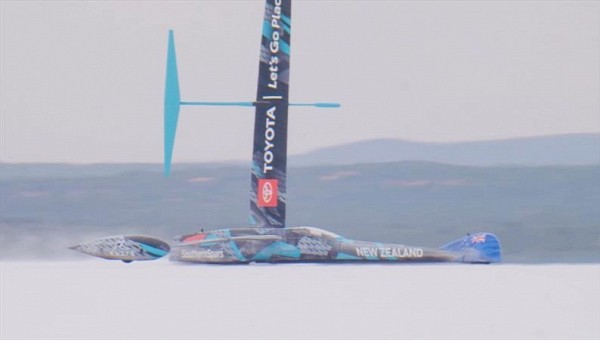Since the very first week of October, the division of Emirates Team New Zealand not preparing for their defense of the America's Cup has been embroiled in a quest of their own.
Project Landspeed, as the Kiwis call it, is an effort by the team to break the wind-powered land speed record in a craft dubbed "Horonuku" by the native Maori. However, since the team first arrived at the site of the attempt in South Australia, the dry lake bed of Lake Gairdner has been anything but dry. Frequent periods of unseasonably wet weather have left the conditions of the lake bed less than optimal to reach and surpass the world record of 202.9 kph (126 mph).
Forecasts earlier in the week promised warmer and drier conditions for existing water to evaporate with southwest winds expected to reach 20-plus nautical miles per hour (23 mph / 37.04 kp/h) for this past weekend.
The forecast held and by Sunday afternoon the team began making runs into late afternoon. This was by far the most positive session the team has experienced thus far. The initial run topped out at 190 kp/h ( 118 mph) in 20 knots of wind (23 mph / 37.04 kp/h), while the second run after a jibe in 22 knots (25.32 mph / 40.7 kp/h) of wind resulted in a speed topping out at 200 kp/h (124.27 mph).
Horonuku and driver Glenn Ashby did another 10 runs in winds that had lightened to 17 knots (19.6 mph / 31.5 kp/h) to get a feel for where they can pick up more speed. A 90 to 95-degree angle to the true wind is where the land yacht generates most of its speed, but steering is tough work until Asby bears off.
In order to qualify for the record, the attempt must be sailed on a natural surface within 1 meter (3' 3.37") of elevation with only a human push-start to get moving. In addition, the record speed must be 1 mile per hour (1.609 kp/h) for at least three seconds above the existing record, meaning a speed greater than 204.5 kp/h (127.007 mph) for three seconds would be required to set the record.
Forecasts earlier in the week promised warmer and drier conditions for existing water to evaporate with southwest winds expected to reach 20-plus nautical miles per hour (23 mph / 37.04 kp/h) for this past weekend.
The forecast held and by Sunday afternoon the team began making runs into late afternoon. This was by far the most positive session the team has experienced thus far. The initial run topped out at 190 kp/h ( 118 mph) in 20 knots of wind (23 mph / 37.04 kp/h), while the second run after a jibe in 22 knots (25.32 mph / 40.7 kp/h) of wind resulted in a speed topping out at 200 kp/h (124.27 mph).
Horonuku and driver Glenn Ashby did another 10 runs in winds that had lightened to 17 knots (19.6 mph / 31.5 kp/h) to get a feel for where they can pick up more speed. A 90 to 95-degree angle to the true wind is where the land yacht generates most of its speed, but steering is tough work until Asby bears off.
In order to qualify for the record, the attempt must be sailed on a natural surface within 1 meter (3' 3.37") of elevation with only a human push-start to get moving. In addition, the record speed must be 1 mile per hour (1.609 kp/h) for at least three seconds above the existing record, meaning a speed greater than 204.5 kp/h (127.007 mph) for three seconds would be required to set the record.






